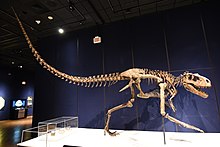Albertosaurus
Jump to navigation Jump to search| Albertosaurus | |
|---|---|

| |
| Mounted cast in the Milwaukee Public Museum | |
| Scientific classification | |
| Kingdom: | Animalia |
| Phylum: | Chordata |
| Clade: | Dinosauria |
| Clade: | Saurischia |
| Clade: | Theropoda |
| Family: | †Tyrannosauridae |
| Subfamily: | †Albertosaurinae |
| Genus: | †Albertosaurus Osborn, 1905 |
| Species: | †A. sarcophagus
|
| Binomial name | |
| †Albertosaurus sarcophagus Osborn, 1905
| |
| Other species | |
| |
| Synonyms | |
| |
Albertosaurus (/ælˌbɜːrtəˈsɔːrəs/; meaning "Alberta lizard") is a genus of tyrannosaurid theropod dinosaurs that lived in western North America during the Late Cretaceous Period, about 71 million years ago. The type species, A. sarcophagus, was apparently restricted in range to the modern-day Canadian province of Alberta, after which the genus is named, although an indeterminate species ("cf. Albertosaurus sp.") has been discovered in the Corral de Enmedio and Packard Formations in Mexico.[1] Scientists disagree on the content of the genus, with some recognizing Gorgosaurus libratus as a second species.
As a tyrannosaurid, Albertosaurus was a bipedal predator with tiny, two-fingered hands and a massive head that had dozens of large, sharp teeth. It may have been at the top of the food chain in its local ecosystem. While Albertosaurus was large for a theropod, it was much smaller than its larger and more famous relative Tyrannosaurus rex, growing up to 8–9 metres (26–30 ft) in length and weighing 1.7–2.5 metric tons (1.9–2.8 short tons).
Since the first discovery in 1884, fossils of more than 30 individuals have been recovered, providing scientists with a more detailed knowledge of Albertosaurus anatomy than is available for most other tyrannosaurids. The discovery of 26 individuals at one site provides evidence of pack behaviour and allows studies of ontogeny and population biology, which are impossible with lesser-known dinosaurs due to their remains being rarer and more fragmentary compared to those of Albertosaurus.

No comments:
Post a Comment